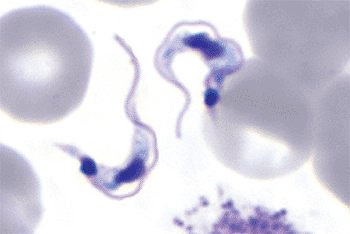Pathogen Reduction Evaluated in Treated Whole Blood
By LabMedica International staff writers
Posted on 21 Feb 2012
The survival of a parasite that can be transmitted by blood transfusion has been ascertained in whole blood treated with a commercial system. Posted on 21 Feb 2012
The system which uses riboflavin (RB) and ultraviolet (UV) light to inactivate pathogens was used to reduce the levels of infectious Trypanosoma cruzi, the causative agent of Chagas disease in whole blood.

Image: Trypanosoma cruzi in thin blood film (Photo courtesy of US Centers for Disease Control).
At the American Red Cross (Rockville, MD, USA), scientists inoculated with 4, 40, 400, and 4,000 trypomastigotes/mL into units of whole blood. The blood was transferred to Mirasol illumination bags, with the addition of 35 mL of 500 µmol/L RB solution, and the bag illumination of with UV light. The units were illuminated with 60, 80, and 110 joules/mL of red blood cells, with sample removal after delivery of each dose. Samples were collected pre- and post-illumination and cultured for the hemoflagellates
All preillumination samples exhibited T. cruzi growth in hemoculture, while postillumination samples from units containing 4 and 40 trypomastigotes/mL showed no signs of viable parasites after 16 weeks of culture. In contrast, at both 400 and 4,000 parasites/mL, two of the three units were positive for viable parasites. The total log reduction observed for T. cruzi was 3.5 log or greater, but less than 4.5 log. This level of reduction is likely to be orders of magnitude higher than what would be expected in a tainted blood donation.
The data from the study suggests that the Mirasol System (CaridianBCT; Lakewood, CO, USA) is able to inactivate clinically relevant amounts of T. cruzi in whole blood and it could be a viable alternative to a serologic screening assay. Additionally, this approach would avoid the need for multiple individual screening tests for other agents in a wide spectrum of marginal risks. Considering the challenges associated with T. cruzi testing, the Mirasol System could represent a useful tool in the quest for blood safety, indicating that the system could be effective at preventing transfusion of the causative agent of Chagas disease.
It has been shown that two decades after immigration, 33/52 (63%) of selected blood donors had polymerase chain reaction evidence of parasitemia and three also had culture-confirmed infection. This affirmation that bloodstream parasites are detectable and potentially transmissible, decades after immigration strengthens the rationale for donor screening or whole blood treatment. The study was published in the February 2012 edition of the journal Transfusion.
Related Links:
American Red Cross
CaridianBCT














